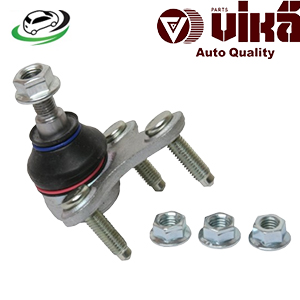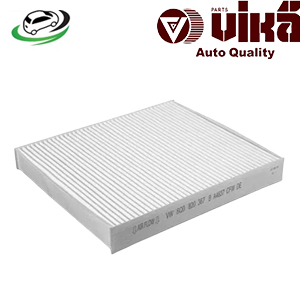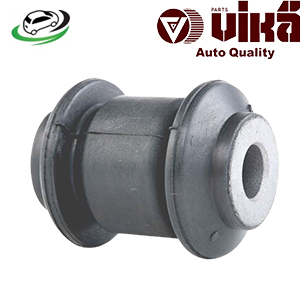-22%
Get VW Polo/Derby (9N2)/(9N5)/ Fox (5Z1) 2005-/ Front Arm Bushing 6Q0407182A
The front arm bushing is a key component in a vehicle’s suspension system, contributing to ride comfort, stability, and handling. It serves as the connection point between the control arm and the vehicle’s chassis, absorbing shocks, reducing vibration, and providing a smooth ride. This detailed exploration will cover the function, importance, types, materials, signs of wear, common issues, and maintenance of front arm bushings in vehicles.
Function of Front Arm Bushing
The front arm bushing, often referred to as the control arm bushing, connects the control arm (a critical suspension component) to the frame or subframe of the vehicle. The control arm is responsible for holding the steering knuckle in place and allowing the wheel to move up and down with the suspension. The bushing acts as a cushioning barrier between the metal parts, absorbing shocks and vibrations while also allowing for controlled movement.
- Shock Absorption: Front arm bushings cushion the connection between the control arm and the chassis. When a vehicle drives over rough terrain, bumps, or potholes, the bushings absorb much of the shock, preventing metal-on-metal contact and reducing the impact felt inside the vehicle.
- Vibration Damping: Bushings reduce the amount of vibration that is transferred from the road to the vehicle’s cabin. Without bushings, the vibrations from uneven road surfaces would be much more noticeable, leading to a harsher and less comfortable ride.
- Controlled Movement: The front arm bushing allows for a limited amount of movement between the control arm and the chassis. This movement is essential for the proper operation of the suspension system, as it enables the control arm to pivot as the wheel moves up and down with the road’s surface.
- Noise Reduction: By providing a cushioning effect, front arm bushings help reduce the amount of noise that enters the cabin from the suspension system. Metal components moving against each other can create noise, but the rubber or polyurethane in bushings helps to minimize this.
- Alignment and Stability: Bushings contribute to maintaining proper wheel alignment. By holding the control arm securely in place while still allowing for necessary movement, they help keep the wheels aligned and prevent excessive play in the suspension system. This contributes to the vehicle’s stability and handling, especially during cornering and braking.
Importance of Front Arm Bushings
- Comfort and Ride Quality: The front arm bushing plays a significant role in ensuring a comfortable ride. It absorbs much of the harshness from road imperfections, contributing to a smoother driving experience. Without properly functioning bushings, drivers and passengers would feel every bump, pothole, or crack in the road, making the ride unpleasant.
- Vehicle Stability and Handling: Front arm bushings help maintain the vehicle’s stability, particularly during braking, accelerating, and turning. By providing a stable connection between the control arm and the chassis, they ensure that the vehicle remains balanced and responds predictably to driver inputs. This improves handling and safety.
- Reducing Wear and Tear: The cushioning effect of the bushings reduces the wear and tear on other suspension components, such as the control arms, steering knuckles, and even the tires. By minimizing direct metal-on-metal contact, bushings help prolong the life of these parts.
- Alignment Retention: Maintaining proper wheel alignment is critical for even tire wear and good handling. Front arm bushings play an important role in keeping the wheels aligned by holding the control arms in place while still allowing for the movement needed to respond to road conditions.
- Safety: Worn or damaged bushings can lead to instability in the suspension system, which can compromise the safety of the vehicle. In extreme cases, the loss of stability can cause the vehicle to handle unpredictably, increasing the risk of an accident.
Types of Front Arm Bushings
There are different types of front arm bushings based on the material used and their design. The choice of bushing can affect the vehicle’s handling, comfort, and durability.
- Rubber Bushings: Most vehicles come equipped with rubber bushings from the factory. Rubber is an excellent material for absorbing shocks and vibrations, providing a soft and comfortable ride. However, rubber bushings can wear out over time due to exposure to heat, chemicals, and road debris.
- Polyurethane Bushings: Polyurethane bushings are a popular aftermarket upgrade for drivers seeking improved performance. While they are stiffer than rubber bushings, they provide better durability and resistance to wear. Polyurethane bushings are less prone to deterioration from oil, grease, and chemicals, making them ideal for high-performance vehicles or vehicles frequently driven on rough terrain.
- Spherical Bushings: Spherical or heim joint bushings are typically used in racing or off-road applications. These bushings provide precise control over the suspension and minimize play, offering excellent handling. However, they sacrifice comfort and tend to transmit more vibrations and noise to the cabin.
- Hydraulic Bushings: Some modern vehicles are equipped with hydraulic bushings, which use a liquid-filled chamber to absorb vibrations. These bushings provide an excellent balance of comfort and handling, but they are more complex and expensive than traditional rubber or polyurethane bushings.
Signs of Worn or Damaged Front Arm Bushings
Like all suspension components, front arm bushings wear out over time. Recognizing the signs of worn or damaged bushings can help prevent more serious issues from developing in the suspension system.
- Clunking or Squeaking Noises: A common symptom of worn bushings is a clunking or squeaking noise coming from the front suspension when driving over bumps or making turns. This noise is caused by excessive movement in the control arm due to the worn bushing, allowing metal parts to make contact.
- Excessive Vibration: If you notice an increase in vibration felt through the steering wheel or seat, it may be a sign that the front arm bushings are failing. As bushings deteriorate, they lose their ability to absorb vibrations, causing more of the road’s imperfections to be felt inside the cabin.
- Uneven Tire Wear: Worn bushings can lead to misalignment of the wheels, which often results in uneven tire wear. If one tire shows significantly more wear than the others, it could indicate that the front arm bushings are no longer holding the control arm in the correct position.
- Poor Handling and Steering Response: Damaged bushings can cause the vehicle to feel unstable, particularly when cornering or braking. The vehicle may wander or pull to one side, and the steering may feel less responsive or “loose.” This is a sign that the control arm is not staying securely in place, affecting the vehicle’s handling.
- Visual Inspection: During a visual inspection, worn or damaged bushings may show signs of cracking, splitting, or complete disintegration. If the rubber is torn or if the bushing looks deformed, it’s time for a replacement.
Maintenance and Replacement of Front Arm Bushings
Maintaining front arm bushings is essential for preserving the overall performance of the vehicle’s suspension system. While bushings are designed to last for many years, they do eventually wear out and require replacement.
- Regular Inspections: Periodic inspections of the front arm bushings, particularly during routine maintenance like oil changes or tire rotations, can help identify early signs of wear. Catching a failing bushing before it completely deteriorates can prevent more significant suspension issues from arising.
- Replacement Interval: The lifespan of front arm bushings varies depending on driving conditions and the material used. Rubber bushings typically last around 75,000 to 100,000 miles, while polyurethane bushings may last longer due to their increased durability. However, harsh driving conditions, such as off-road driving or frequent exposure to extreme temperatures, can shorten the lifespan of bushings.
- Cost of Replacement: Replacing front arm bushings typically costs between $150 and $400 per side, depending on the make and model of the vehicle, labor costs, and whether you choose OEM or aftermarket bushings. If other suspension components, such as control arms or ball joints, are also worn, they may need to be replaced at the same time.
- DIY Replacement: While it is possible for experienced DIY mechanics to replace front arm bushings at home, it can be a complex job that requires specialized tools, such as a press, to remove and install the bushings. Improper installation can affect the alignment of the suspension, so professional installation is recommended unless you have the necessary expertise.
- Alignment Check: After replacing front arm bushings, it is essential to have the vehicle’s alignment checked and adjusted if necessary. New bushings may change the geometry of the suspension, and proper alignment ensures that the vehicle handles correctly and tires wear evenly.
Common Issues and Solutions
- Premature Wear: In some cases, front arm bushings may wear out prematurely due to poor-quality materials or driving conditions. For example, driving on rough roads or exposing the bushings to excessive heat or chemicals can cause them to deteriorate faster. Upgrading to polyurethane bushings can offer increased durability in such conditions.
- Bushing Deformation: Over time, rubber bushings may deform or become misaligned due to constant exposure to stress and movement. This deformation can cause the control arm to move excessively, leading to alignment issues and poor handling. Replacing the bushings promptly can restore proper suspension function.
- Noise After Replacement: If a newly installed bushing is not properly lubricated or seated, it may cause squeaking or clunking noises. Ensuring that the bushings are correctly installed and using appropriate lubrication can prevent this issue.
Conclusion
The front arm bushing is a critical component of the suspension system that plays a significant role in absorbing shocks, maintaining vehicle stability, and ensuring a smooth ride. Regular inspection and maintenance of front arm bushings can help prevent wear-related issues, while replacing worn bushings can improve handling, ride comfort, and safety. Whether made of rubber or polyurethane, these components ensure that the vehicle remains responsive and comfortable for both daily driving and more demanding road conditions. By addressing bushing wear early, vehicle owners can enjoy optimal suspension performance and prolong the lifespan of other related components.
Follow us on Facebook for more parts.




Reviews
Clear filtersThere are no reviews yet.